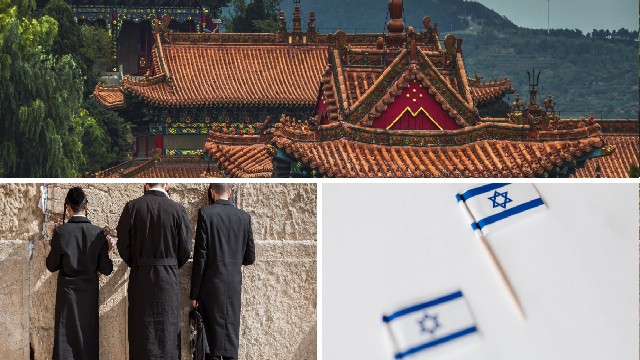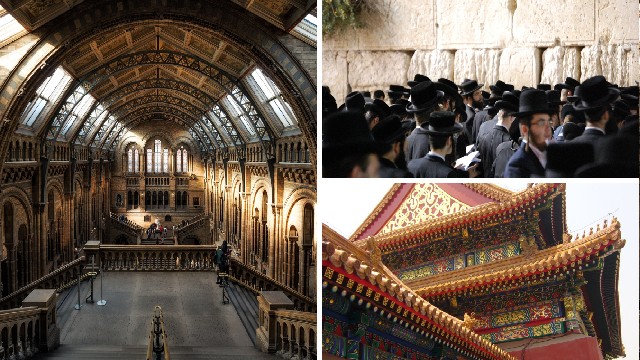The miracle of Shanghai: How China Saved 20,000 Jews during World War II
This is a sign that does not seem to be in the right place. Near the cities gleaming skyscrapers in central Shanghai, I saw an old brick building with the Star of David on it. This sign of the Jews is so small that passers-by may not be able to see it. However, it marks one of the most extraordinary stories in Shanghai’s history. The incident took place in the Telangana area.
The Chinese city was the last refuge for thousands of forced laborers in the 1930s. During the persecution in Nazi Germany, many countries and cities banned Jews from entering. But Shanghai: was not on the list. The multicultural shelter housed British, French, American, Russian and Iraqi citizens. It was one of the only places where Jewish refugees were allowed to enter, even without a visa.
The Star of David on this old building in Shanghai is a testament to Jewish history
For more than 20,000 homeless Jews from Germany, Poland, Austria, and other countries, Shanghai: was more than 7,000 kilometers away. Nevertheless, between 1933 and 1941, they arrived in China's largest city to escape the Holocaust. But Shanghai: was not the only safe haven for them.
It was a modern city where Russian Jews formed their community more than a decade ago. They built the building where the Star of David was inscribed. His name is Ohl Moshe Synagogue.
At the beginning of the trip, the people of Shanghai: were at peace with the arrival of their new guests. Shanghai residents welcomed Jewish refugees and formed a strong community, including schools, where social relations were good. Some refugees started working as dentists and doctors. The rest built shops, cafes, and clubs.
But these refugees did not know that despite traveling around the world, they would one day fall into the hands of Nazi Germany's most powerful ally. In 1941, Japan occupied Shanghai: At the behest of the Nazis, Japanese troops rounded up all the Jews in the city and imprisoned them in Telangana. Thus the Jewish slums in Shanghai: came into being.
A plaque in Hoshan Park describing the Jewish slums
These dark chapters of
history was circulating in my mind when I stopped at a stone slab in Hoshan
Park, Telangana. There are many plants in this small park. As I was
photographing the plaque, some elderly Chinese people were surprised to see
me. Telangana's Jewish history may not have
attracted so many international tourists, but it is one of the city's main
tourist attractions.
It was home to more than 15,000 Jews in the early 1940s.Hoshan Park was like a public living room where Jews used to gather during the day. Unlike the Jewish slums in Europe, Telangana was not fenced.
Many Jewish slums still exist in Shanghai
"Imagine you were a
doctor, a lawyer, or a musician in Vienna, and all of a sudden you become
unemployed and live in the slums of Shanghai:"
The 1930s According to Bargall, even before the Japanese intervention, many Jewish refugees were living in poverty in Telangana compared to their luxury in Europe. The situation worsened when Japanese troops gathered Jews from all over Shanghai: and forced them to live within the boundaries of this new slum. The Japanese were not allowed to leave. He could not work without the permission of Japanese officials and was rarely allowed to do so.
Crowds in homes have led to an increase in illness and malnutrition. According to Bargall, "it went from a poor area to a very poor one."
Shanghai: was one of the cities where Jews were allowed to enter in the 1930s
"Many people did not have a job and were forced to live in shared houses where beds, bathrooms and kitchens had to be shared. There were no secrets in their lives and they were almost deprived of food.
However, the Holocaust killed about 6 million Jews and killed 14 million Chinese soldiers and civilians during the war with Japan between 1937 and 1945. Meanwhile, the majority of Jewish refugees in Shanghai survived.
Historian David Cranser called this extraordinary story the "Miracle of Shanghai" According to Bargall, the Jews survived because they were not the main target of Japanese forces.
In 1945, World War II ended with the defeat of Japan and Nazi Germany. The Japanese troops withdrew and the Jews in Shanghai began to evacuate. They settled in countries like the United States, Australia and Canada.
But if Shanghai had not accommodated the refugees at the time, perhaps more than 20,000 Jews would not have survived the Nazi death squads.
The museum contains memories of the time when Jews took refuge in Shanghai
These days, the majority of Chinese citizens live in Telangana, and hardly any foreigners are seen here. There are less than 2,000 Jews in Shanghai. According to Bargall, the number was close to 4,000 before the global coronavirus outbreak.
He says none of them know if any of their Jewish relatives have lived in the slums. But many of the refugee's descendants have visited Telangana. These people might not have been born otherwise.
Before the global
plague, Bar-Gal used to tell Jewish tourists how their ancestors
lived in these dilapidated buildings. He remembers the experience as he
left Shanghai last year due to an
outbreak of the epidemic and suspended his tour.
Nevertheless, the story of this Jewish slum can still be found in Shanghai. Jewish Refugee Museum. It is located in the Ohel Moshe Synagogue. During World War II, this synagogue became a place of communion.
It was then turned into a museum in 2007 and reopened after being rebuilt last December. According to its website, its purpose is to explain how Shanghai built the 'modern Noah's Ark' for the Jews.
The hall of the synagogue is used as the entrance to the museum and has not been changed since its use. According to Sofia Tian, director of the museum's exhibition and research department, the exhibits show the deeply personal stories of Jewish refugees as well as the formation of Telangana's Jewish community.
I was particularly impressed by the story of Dr. Jacob Rosenfeld. The Jewish immigrant arrived in Shanghai from Austria in 1939 and has since joined the Chinese army in the war against the invading Japanese, working as a field doctor, and saving the lives of several wounded Chinese soldiers.
After being awarded several Chinese military medals, Rosenfield returned to Austria with his family in 1949. Another exhibition features emotional memories of Jerry Muses, who was only six years old when he and his family fled Germany to Shanghai in 1941. "If the people of Shanghai were not so tolerant, our lives would be miserable," he said. If a Jew escapes to Europe, he has to go into hiding, and here in Shanghai we can dance, worship, and do business. "
The museum also encourages free visits to ghettos by providing detailed booklets with historical Jewish sites and maps of Telangana. These booklets contain the details in English. Walking through its streets, I was able to imagine what Talanciao must have looked like 80 years ago when Japanese troops invaded Shanghai.
The first structure I came across during this visit was the ancient Tilakiao prison. During World War II, the Japanese detained dozens of Jewish refugees and dissenting Chinese behind the prison's thick stone walls. The barbarism of the Japanese gave the Jews and the Chinese a common enemy and experience. According to Tian, the relationship is still strong today.
"The Jewish community has established a special bond of cooperation and love with the natives of Shanghai," he said. They brought European culture to Shanghai and remained harmonious and culturally connected with the locals.
Then on Qingjiang Road, I passed by a former Jewish sanctuary. Now mostly apartments, these seven high-rise buildings housed more than 3,000 Jews in the early 1940s. The area near and adjacent to the Hoshen and Xoshan highways was once known as Little Vienna and was a prosperous part of the Talanciao Jewish neighborhood.
In the late 1930s, these streets were the backbone of Shanghai’s Jewish community and the center of regular social events in the Mascot Roof Garden, located above the Jewish business and the former Broadway Theater. This beautiful building of deco art, now a small hotel, was a source of joy for the city's Jews before World War II.
Such actions were necessary to maintain the spirit of the Shanghai Jewish community, as most of their families, were still in danger in Europe. At a time when businessmen from all over the world were coming here, Shanghai became the fifth largest city in the world from a fishing village. Tlankiao did not offer wealth or luxury to Jewish refugees, but rather security.
Even today, eight decades later, the world echoes the stories of survival that took place here. And if you search for the Star of David and step into a holy shrine that still exists today, you can learn the inspiring story of how China sheltered frightened Jews who had no rights and no hope of returning home







